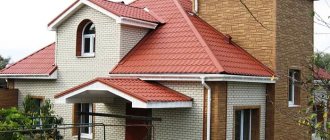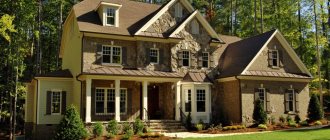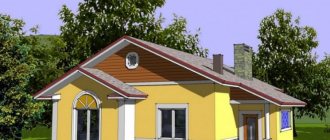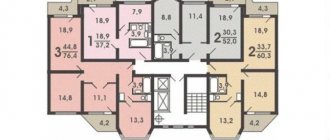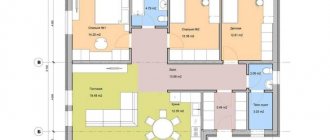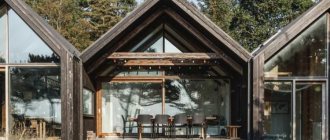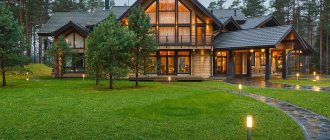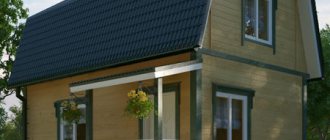One of the most famous devices for determining the direction of the wind is a weather vane.
They were first used by sailors and fishermen before going to sea. Subsequently, weather vanes moved from ships to coastal houses, and the tradition of installing them began.
Today, a weather vane is an excellent design move that can give individuality and introduce some classic feature from the past.
Basic elements of a weather vane
The operating principle of the device is based on the influence of air currents, which set the arrow with a figure in motion. The standard design includes four key elements:
- A metal pipe with a bearing inside, securely fixed to the roof.
- Wind rose, intended to indicate cardinal directions. To do this, two metal rods are crossed at right angles, at the end of which letter designations are fixed.
- The axis is made of reinforcing rod, ensuring free rotation of the pointer due to fixation in the bearing.
- A weather vane, the role of which is an ordinary arrow or a flat figure.
The correct design of the weather vane ensures that the pointer points in the direction from which the wind is blowing. The simplest and most accurate example of a device is a arrow with feathers.
Advice! If you want to install an original figure in the form of a rooster or any animal on the roof, you need to choose the drawings wisely in order to avoid sail balance. The tail of the weathervane must have windage.
Choosing a location for installation
For the weather vane to operate as efficiently as possible, even with minimal wind, it must be installed as high as possible and preferably away from tall trees that will shade it from air currents. As a rule, the weather vane is installed on the ridge of the roof, as in the photo. A roof with a straight ridge is the most common type, so most people who want to install a weather vane will have this option when choosing a location.
The main thing is to ensure that the weather vane is securely fixed to the roof, since the structure is made of metal and is therefore quite heavy. For maximum sensitivity to changes in wind direction, it is necessary to fix the structure vertically on the revolving mechanism, avoiding tilting to the side, which will lead to an increase in resistance in operation and the figure will freeze on the roof in one position.
It is also possible to install a weather vane on the roof spire, as in the example shown in the following photo. This method of fixation looks even more spectacular, because it seems that the cockerel is balancing on a thin pole. Since most houses do not have such spiers on their roofs, the figurine can be mounted on a gazebo. It will be just as beautiful, but most likely the cockerel will turn only in medium and strong winds. For good work at low heights, you can take a large figure, which will increase the area of contact with air gusts, but on small buildings this will not look very attractive.
Types of devices and material for manufacturing
Among the variety of weather vanes, there are several main types of devices:
- Meteorological devices undergo careful balancing during manufacture. High-precision instruments are used at weather stations.
- The Wilde weather vane is designed to measure the strength of wind gusts. The degree of deviation of the vertical plate from the zero position determines the wind intensity.
- A weather vane on the roof that prevents the chimney from blowing in and increases its draft is called a deflector.
- Decorative designs that are extremely popular among private home owners, despite inaccurate readings.
The figure for the weather vane is often chosen taking into account its mystical meaning. The image of a rooster is especially popular. A weather vane with the outline of a rooster installed on the roof, according to popular beliefs, wards off evil spirits, blocks the path of thieves and protects against fires. A windsock in the shape of a stork symbolizes the reliability of the family hearth and favors the birth of a new life.
When preparing a drawing of a weather vane, you should adhere to the standard dimensions of the weather vane, which range from 40x75-80x120 cm.
To create a weather vane indicator, various materials are used:
- Galvanized steel or other non-corrosive metal. The most suitable design option, guaranteeing a long period of use.
- Tin or plywood are the second most popular materials when making a roof windsock. By choosing a rooster figure made of plywood as a weather vane, you can decorate it with bright colors that are resistant to moisture.
- Wood and plastic are used much less frequently.
- There are extraordinary weather vanes made from plastic bottles or CDs.
An intricate rooster on the roof is shown in the photo:
How to install a counterweight
At the end of the installation, a counterweight is installed. The weight of both the plate and the counterweight must be taken into account, otherwise the device will not function properly. If you have a drawing, installation is easier.
After the weather vane is fixed, it is painted with external paint or covered with enamel. Correctly performed installation requires relative rigidity - you should not overtighten the weather vane with fasteners. Otherwise, they will be highly susceptible to wind loads.
An original weather vane can be purchased at a building materials store, focusing on its functionality and symbolism.
Plywood construction
Lack of skills in working with metal is not an obstacle if the idea arises of installing a weather vane topped with an image of a rooster on the roof. Waterproof plywood is suitable as a base for the weather vane. The following drawings will help you choose an interesting rooster model for the roof:
The procedure includes the following steps:
- The drawing you like is printed and enlarged to the required size on thick cardboard. To make it easier to transfer the image of the rooster, it is better to divide both sheets into sectors.
- Cutting out the weather vane shape onto the roof is done with a jigsaw.
- The uneven outlines of the rooster are sanded.
- Depending on the chosen roof weather vane design, the parts are connected to each other (if the rooster figure consists of several elements).
- A block with an inserted bearing is mounted to the bottom of the rooster figure.
Comment! To glue individual parts, use only waterproof glue. - The weather vane is treated with waterproof paints or colorless varnish.
- While the structure of the rooster for the roof dries, we move on to creating the fastening.
- The axis is a wooden beam or a metal rod, the diameter of which corresponds to the size of the installed bearing on the weather vane. One edge of the rod fits into a bearing attached to the rooster figure, the other into a similar mount on the body (stand) of the weather vane.
- A compass rose with letter symbols is installed on a fixed stand.
The accuracy of the pointers will ensure the use of a compass. Advice! When using wooden elements in the structure, carefully connect the fasteners, otherwise the accuracy of the indicators of the weather vane on the roof will be impaired.
The principle of operation of a chimney weather vane
There are so-called chimney weather vanes, and their importance for the normal operation of chimneys is very great. You can choose designs that help drain rainwater and protect pipes from birds and even small animals. It is worth noting that the smell from a burnt nest that a bird made in the summer will be simply unbearable. Weather vanes that are designed to protect chimneys are called weather vanes, chimney caps or chimney caps.
- The protective role of the weather vane
A smoker, or weather vane, is used to cover an open chimney pipe. This device performs protective and decorative functions. Chimneys are installed above the pipe and visually complete it. The problem with this device is that the weather vane bearings need to be periodically maintained and lubricated. In winter, ice forms on the surface of the chimney due to the steam contained in the smoke, which needs to be knocked off.
The main task of a chimney weather vane is to prevent backdraft. It is worth noting that conventional caps that are installed on chimneys are just the opposite.
Evgeniy Filimonov
Ask a Question
may contribute to backdraft if strong winds blow.
As noted above, the design of a weather vane includes an axis, a figure and a cross indicating the cardinal directions, which distinguishes it from a simple cap. This device gives the chimney pipes an aesthetic, finished look.
Why is it worth installing this type of weather vane on the chimney? This decorative element provides effective wind protection, which is especially important for the northern regions of the Russian Federation. Its design helps deflect the air flow and prevent it from being blown into the pipe. Chimney weather vanes are equipped with a special damper that closes the chimney from the wind. This element allows smoke to exit the chimney calmly from the leeward side. Thus, a draft is formed that removes combustion products.
The weather vane on the chimney prevents raindrops and snow from falling directly into the channel. To prevent the resulting condensate from penetrating inside the pipe, special drips are installed on the wind vane. Without such a design, the upper part of the chimney will get wet and collapse. In winter, condensation will enter microcracks in the chimney. After freezing, water droplets in the pores of building materials will expand. Constant expansion and contraction due to freezing/thawing of moisture significantly accelerates the destruction of the chimney.
- Weather vane deflector
Another type of chimney weather vane is called a deflector. The term "deflector" refers to its ability to deflect air currents. The design of such weather vanes, as a rule, includes two cylinders, above which cone-shaped umbrellas are fixed.
The principle of operation of such a device: the air flow, resting against the wall of the upper glass, bends around it and is directed upward. As a result, the speed of air movement inside the pipe increases, which leads to increased draft in the chimney. Air flows moved by the wind are diverted by the upper cone-shaped cap and do not enter the pipe.
A correctly selected weather vane-deflector model will not only prevent the occurrence of reverse draft, but also enhance the removal of combustion products. The fact is that the weather vane, turning with a cone towards the air flow, creates turbulence. It should be taken into account that in winter ice may appear on its surface, blocking the operation of the device, so you need to get rid of it periodically.
When installing a weather vane deflector on a chimney, you should use only bearings that are protected from moisture. During operation of the device, it is necessary to lubricate such bearings once a year. Modern models of weather vane deflectors usually have the shape of a crown or a crown that adorns the top of the pipe.
Metal pointer
A weather vane where metal was used to make the rooster will look much more impressive on the roof.
Options for drawings and methods for transferring them to metal
We offer a choice of several photos with interesting sketches of rooster figures, using which it will be easy to create your own weather vane drawings.
Less common, but no less attractive, are weathervanes with storks on the roof. You may want to install just such a structure on the roof, made according to the photos with drawings below:
Please note that the optimal image of a rooster for the roof is positioned in such a way that the tail part is 1.5-2 times larger than the front part. This will ensure that the weather vane needle turns towards the wind.
Having previously cut out on paper all the holes that the rooster figure contains, the image is transferred to metal. Stainless steel with a thickness of 1.0-1.5 mm is suitable for these purposes. You can do this as follows:
- The paper drawing is fixed on the base of the weather vane and traced with a special tool, leaving a noticeable scratch on the metal.
- The second way to transfer the drawing is to fix it on the selected material and spray paint over the sketch of the rooster. Then all unnecessary areas for the future weather vane will be painted over.
- To form the figure of a rooster on the roof, use a chisel, after which the pointed edges are sanded.
- On a production scale, laser cutting is used to create a weather vane, where the drawing is processed using a computer program.
- Before installation on the roof, the figure is coated with an anti-corrosion agent, after which it is painted or the rooster is left plain.
Weather vane with which symbol to choose
Over its long history, the weather vane has become the hero of many legends. It acts not only as a decorative element of the house, but as a kind of amulet. According to Feng Shui, it is believed that a weather vane ensures warm and friendly relations with neighbors.
The most common are weather vanes in the shape of a rooster. Such models are very popular in Russia. This bird symbolizes vigilance. According to popular beliefs, the rooster scares away evil spirits and protects the house from fires and other troubles. As noted above, among Christians this bird is considered a symbol of St. Apostle Peter.
The wolf on the weather vane figurine can have several meanings. The positive characteristics of this symbol are associated with victory, courage and caring for family. In addition, the wolf often acts as an emblem of warriors. This image is applied to the coat of arms (in this case it symbolizes vigilance and caution). At the same time, the wolf can serve as the personification of cruelty and deceit. In certain situations, he becomes the protector of the helpless. The presence of a wolf symbol on a weather vane indicates the leadership qualities of the owner of the house, for whom family values are the most important.
According to Feng Shui, the dragon attracts success in business. And if this symbol is supplemented with a pearl, then it symbolizes material wealth and spirituality. The dragon combines an active position and health. It is considered a symbol of hidden knowledge, wealth and longevity. This is a sign of openness and purity of thoughts. He does not have such qualities as envy and hypocrisy. Weather vanes with a dragon figure are a good choice for the roof of an entrepreneur’s house. Such a talisman will protect you from troubles and attract success in business.
Evgeniy Filimonov
Ask a Question
In Asian countries, weather vanes with figures of dragons are very popular. They are considered a reliable talisman for the home.
When choosing the appearance of a weather vane, you should pay attention to the meaning of different symbols. For example, a cat symbolizes homeliness, an eagle protects from enemies, a lion gives strength and demonstrates power, a ship symbolizes determination, and a stork symbolizes home. When choosing a weather vane, it is not at all necessary to focus only on the meaning of different symbols. Choose any figure that you like.
Since ancient times, a weather vane could also serve as a signpost with information about who owns the house. That is why his figurine often looked in such a way as to tell about the homeowner’s profession (the partner’s weather vane was shaped like a boot, etc.).
To expand the range of choices, here are the most popular types of symbols for weather vanes:
- Animals used on farms represent wealth and family traditions.
- The stork represents happiness in family life.
- A weather vane in the shape of a scorpion is a sign that serves as protection from enemies.
- The airplane as a flying machine demonstrates freedom and sublimity. This symbol speaks of assertiveness and independence.
- A weather vane in the shape of an airplane is a conqueror of all airspace.
- A weather vane-turntable in the shape of a frog will help in the most difficult situations. The frog loves water and is not afraid of any bogs. In case of danger, she can find salvation both in the water element and on land.
- Cats not only symbolize homeliness. They have some kind of mystical component, because it is not without reason that they are believed to have seven lives.
- Weathervanes in the shape of sailboats symbolize determination, fortitude and help achieve goals.
- The griffin combines two elements: air and earth. A weather vane with a symbol of this type indicates self-confidence and power.
- The horseman is a sign of a warrior and a winner. It symbolizes experience, authority and charisma.
- The horse serves as a symbol of speed, agility, nobility, wisdom and intelligence.
- It is believed that a chimney sweep on a weather vane attracts happiness and changes for the better.
- Fish is a positive symbol that is associated with sexual energy and fertility.
- A weather vane with Pegasus indicates swiftness and determination.
- A weather vane in the shape of a deer is a sign of a noble warrior who fights evil.
- The lion on the weather vane has always been a symbol of power, wisdom, sun, strength and courage.
- The arrow symbolizes the desire for the heavenly.
Regardless of the type of figure, the weather vane should be placed in the highest and most open place on the roof. A chimney or roof ridge is best suited for this purpose. It is good if the weather vane is visible from the window of the house. This will allow you to determine the wind speed and direction right from your home.
Connecting elements
The key component of the weather vane on the roof is the rotary axis, which rotates due to fixation in bearings. This part of the design of the weather vane with a rooster must be reliably protected from moisture. The entire process of connecting a roof structure consists of the following steps:
- A half-inch pipe, 125 mm long, is suitable as a base for the weather vane. Its upper part contains a thread for fixing the lid.
- A bearing is placed in the lower edge of the support; its size must correspond to the diameter of the axis to ensure free rotation of the cock-shaped weather vane on the roof.
- A cover is attached to the support, on top of which there is a wind rose. Installation of signs must be done using a compass.
- To make it, you will need two metal rods connected perpendicular to each other. Directional indicators in the form of letters are attached to the edges of the structure.
- A metal rod, which acts as an axis for the rooster on the roof, is inserted into the support pipe.
Its approximate length is 45 cm. Note! If you take a rod with a thickness of 10 mm and a bearing with an internal diameter of 9 mm, the edge of the metal rod must be ground down to 9 mm to match the dimensions of the bearing. - The place where the rod exits the weather vane body is covered with a cap to protect it from moisture.
- An arrow with a rooster figure is welded onto the rotating axis.
The diagram below clearly demonstrates all the main design elements for installing a rooster on the roof.
Rotating mechanism of weather vane
In order for the weather vane to work correctly, for a long time and quietly, you should carefully consider the mechanism for turning it. It must be as reliable and durable as it is sensitive.
During assembly, you can use one of the following technologies:
- On bearings. This method is considered the most reliable, durable and successful in terms of absence of noise. You need to take a round steel pipe and press standard rotation bearings into its ends. Then the pipe is fixed on the roof, and the pointers are welded to it. A pin or pipe is welded to the body of the weather vane, the cross-section of which corresponds to the internal hole of the pressed bearings. The scheme is complex, but practical. The collapsible design will make it easier to access the windmill for maintenance, repair or replacement.
- On a ball. Pipes with different sections are used, when the inner diameter is 1-2 mm smaller than the outer one. A steel plug is welded or a wooden plug is driven into the middle of the larger pipe. Then pieces of narrow pipe are welded to the roof and weather vane. All that remains is to connect the fragments, having first filled the upper part of the outer casing with lubricant.
When choosing a method for manufacturing a rotating mechanism, you need to use the most durable and reliable parts. The windmill will be in operation almost constantly. The impact of friction leads to rapid wear of parts, vibration and loud noise. The best solutions are water pipes, bicycle and car bearings.
Why do you need a weather vane on the roof?
What is a weather vane? This is a special device that allows you to determine the direction of the wind using a metal flag with a counterweight that rotates along an axis. In this system, it is the counterweight that shows the direction of the wind. Depending on the purpose there are:
- meteorological - these are special high-precision instruments that measure the strength and direction of the wind;
- decorative - their main function is to decorate the building, the readings are not particularly accurate;
- chimney - installed on the chimney pipe to prevent possible attenuation;
- Wilde weather vane - its design combines all two devices, thanks to which it is possible to determine not only the force, but also the speed of air masses.
Content
- Why do you need a weather vane on the roof?
- Weather vane symbolism
- Design and principles of installing a weather vane on the roof
- The material from which the weather vane is made
- Installation of a weather vane on the roof
- Making a weather vane with your own hands
- Video
Many owners of country houses strive to create a unified design - to tie together the exterior and interior of the building. For this purpose, various decorative elements are used, one of which is a weather vane. Currently it is a work of art. A large selection of different shapes will allow you to choose exactly the one that will characterize you and tell you about your hobby.
